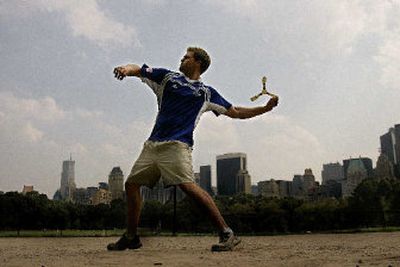Boomerang nationals return

NEW YORK – Barnaby Ruhe is so accurate with a boomerang that he can throw it and hit an egg sitting on top of his head.
Adjusting for the wind in Central Park, Ruhe whipped his specially designed boomerang out on a 100-foot elliptical path toward the Manhattan skyline, danced under it and … SPLAT!
“Got it,” someone shouted among a few curious onlookers at Sheep Meadow.
Ruhe gave the demo of his egg-cracking talents before heading with defending champ Matt Golenor and some 40 others to the U.S. Boomerang Championships this weekend in New Hampshire.
Egg cracking won’t be contested at the event, but the throwers will be tested in four areas: accuracy, distance, speed and trick catching.
Dozens of multicolored and multishaped boomerangs were pulled out of bags for an exhibition this week in 97-degree temperatures in the heart of Manhattan. A few got caught up in trees, and one nearly skimmed the top of a park police car before hitting a fence.
The heat didn’t seem to bother Suzanne Ragan Lentz, another competitor.
“For me, it’s about the beauty of the flight of the boomerang,” Lentz said. “You throw the stick out and it turns and comes back to you. It’s magical.”
The 58-year-old Ruhe, a six-time World Cup champion, has been throwing a boomerang for 30 years.
A portrait artist whose subjects have included politician Jerry Brown and rocker Grace Jones, he also teaches a course on rituals and shamanism at New York University.
“Virtually every boomeranger has two lives,” Ruhe said.
His “eggsploits” have appeared on “Ripley’s Believe It or Not” television show. He’s given boomerang demos in China, Germany, Japan and Hungary and is working on a book called “Zen Boomerang,” about karma, pollution and the environment.
“What you throw out is what you get back,” he said.
He started out knocking an apple off his head (getting lots of William Tell references) and moved onto eggs for the louder applause. On his third attempt in Central Park, he splattered the egg.
“It’s visual and metaphysical,” he said. “The egg is the point of origin and the finale – scrambled eggs.”
Ruhe designed the two-armed polypropylene blade – it looks like a “Star Trek” insignia curled up at the ends – to come back flat instead of at an angle. His specially designed cap has a round disk sander inside. He attaches an apple to the peg that pokes through the top of the cap, then uses chewing gum to adhere an egg to the apple.
He’s the target, but said he has only been whacked a few times and has had more than 100 successful attempts.
“Most people don’t do it because boomerangers are sensible people,” he quipped.
Thirteen-year-olds Will Morgan and Mark Slawson, visiting with their moms from Jackson, Miss., happened upon the demo.
“I’ve never seen it before – really awesome,” Morgan said.
Golenor gave the boys throwing tips, pinching one arm of the boomerang between his thumb and forefinger and holding it vertical to the ground.
“Pretend you’re knocking on a door,” he said. “Toss it out and over the top. Snap your wrist like you’re throwing a football for a 10-yard pass versus a 30-yard bomb.”
For beginners, a four-bladed plastic boomerang is lighter and doesn’t travel far, making it easier to retrieve. Morgan’s best toss returned within 6 feet of him.
“It’s pretty hard,” he said.
Golenor can whip a boomerang hard enough to create a helicopter-like “whoop, whoop” sound, have it return on a dime and catch it behind his back, between his legs or kick it off his foot for a hackey sack-like catch.
The 27-year-old Golenor, a math teacher from Nashville, Tenn., got started a few years ago when a friend gave him a boomerang from Australia. He got hooked after his first tournament.
His specialties are trick catches and fast catch (fastest five throws and catches). His maximum time aloft (MTA) personal best is 2 minutes, 18 seconds.
The MTA boomerangs are made of a high-tech carbon fiber wrapped over tiny air bubbles that keep them flying longer.
“You throw it 150 feet up and it catches a hot pocket of air and keeps going,” he said. “And somehow it magically returns.”
The sport has had a boomerang effect on Lentz, who competed in her early 20s and left it for five years to pursue her masters degree in art.
She felt more welcome the second time around in the male-dominated boomerang world, where men and women compete together. In the past, males got more attention and help from experienced throwers.
“It’s better now because I was part of the old guard,” Lentz said. “They were afraid of a woman beating them.”
The boomerang has its origins as a weapon used by Australian Aborigines, but it also has been found in archaeological digs in Egypt and Europe, she said.
The modern sport of boomerang started in the 1960s, and 25 countries have national boomerang organizations and a World Cup is held every two years.
At the U.S. championships, Golenor’s toughest competition is expected to come from Chet Snouffer, a 12-time U.S. champion, as well as the wind.
“Mother Nature makes the greatest of throwers the biggest of fools,” he said.
At the U.S. championships, whoever earns the fewest points in various events wins (one point for first place, two for second). A selection committee will determine which Americans go to the 2006 World Cup in Japan. A U.S. team has won seven of 11 World Cups held since 1987.
“You have to be a generalist and have endurance,” Lentz said. “We ran a tournament in Seattle in June, and 18 people were on the field for eight hours.”
She acknowledges it’s a “horrible spectator sport,” but the camaraderie is what keeps her coming back. And the soaring aesthetics.
“It creates this really beautiful pattern in the sky,” she said.